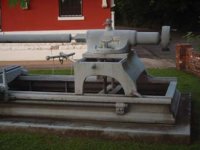Selma Hunter
Established Users
The attached photo is of a "cannon" lathe actually used in Selma during the late unpleasantries. It is currently sited at the entrance to the Old Depot Museum in Selma not far from where it would have once been used to turn Confederate instruments of war. How large a cannon this might have been used on is subject to some discussion, however this lathe would have been just about right for turning fittings and accessories used on carriages, gun mounts, shells, bolts, sabots or anything else sizable that needed turning. A lathe this size could have been used for work on field rifles and other smaller pieces of ordinance.
Some of the records I have seen indicate the actual horsepower of the engines at the foundry shops and the length (in feet) of the shaft system delivering that power to the shop floor (not much actually by todays standards). One other lathe of this type is on display on campus at Auburn University (near Sanford Hall). The large item in the foreground is an anchor for those of you who might think it is an Alabama bream hook.
While Selma was a bit slow getting up to speed as an Army Arsenal and Naval foundry (compared to others) it was a substantial manufacturing center by late 1863. Selma and Corinth, MS were two of the key transportation centers in the South during the war.
Some of the records I have seen indicate the actual horsepower of the engines at the foundry shops and the length (in feet) of the shaft system delivering that power to the shop floor (not much actually by todays standards). One other lathe of this type is on display on campus at Auburn University (near Sanford Hall). The large item in the foreground is an anchor for those of you who might think it is an Alabama bream hook.
While Selma was a bit slow getting up to speed as an Army Arsenal and Naval foundry (compared to others) it was a substantial manufacturing center by late 1863. Selma and Corinth, MS were two of the key transportation centers in the South during the war.





